3 Promoting Efforts to Address Global Issues and Human Security
(1) Health and Medical Care
It is said that roughly at least half of the world’s population has no access to basic medical care and more than 5.2 million children Note 39 under the age of five die annually due to preventable diseases. Over 295,000 women Note 40 die during and following pregnancy and childbirth per year, primarily due to the lack of emergency obstetric care provided by obstetricians, gynecologists, and/or midwives.
Sustainable Development Goal (SDG) 3 aims to “Ensure healthy lives and promote well-being for all at all ages.” In addition, in order to respond to various health issues, which differ across countries and regions, achieving “universal health coverage (UHC)” Note 41 is positioned as an important international goal.
Human Security
The Sustainable Development Goals (SDGs) present a vision of a prosperous and vibrant society where “no one is left behind.” This is in concurrence with the concept of “human security” that Japan has been promoting for many years, which seeks to build states and communities by protecting and empowering individuals so that they can live in dignity, free from fear and want. In the Development Cooperation Charter, human security is also positioned as the guiding principle that lies at the foundation of Japan’s development cooperation, and in order to promote human security, the Government of Japan undertakes various efforts both to (i) spread the concept and to (ii) put it into practice on the ground.
(i) Spreading the concept
After the unanimous adoption by the UN General Assembly of the resolution concerning common understanding of human security led by Japan in 2012, Japan continues its efforts to promote the concept. In his address to the General Debate of the UN General Assembly in September 2020, then Prime Minister Suga proposed deepening discussions on a new concept of human security in light of COVID-19, and a High-Level Advisory Panel was established under the UN. Based on the panel’s discussions, the Special Report on Human Security - New Threats to Human Security in the Anthropocene was released in February 2022.*1At the same time, the Group of Friends of Human Security*2 was relaunched at the UN Headquarters in New York. The first meeting of the Group of Friends of Human Security was held in June 2021 in the presence of UN Secretary-General Guterres, and the second meeting was held in December of the same year.
(ii) Putting the concept into practice on the ground
Japan spearheaded the launch of the “UN Trust Fund for Human Security” in 1999 and has contributed approximately ¥48.4 billion in total by the end of FY2020. The trust fund has supported 267 UN projects to ensure human security in over 100 countries and regions by the end of 2020.
*1 Overview of the special report: https://hdr.undp.org/content/2022-special-report-human-security
*2 The Group was created in 2006 and held a total of seven meetings until 2009, which led to a UN General Assembly Resolution on human security adopted in 2012. Recognizing that discussions on the concept of human security should be reinvigorated to aim for recovery from COVID-19, the Group of Friends of Human Security was re-launched with the UN Permanent Representatives of Japan, Costa Rica, and Senegal as co-chairs.
● Japan’s Efforts
■ Promotion of UHC (Japan’s Initiatives at International Conferences)
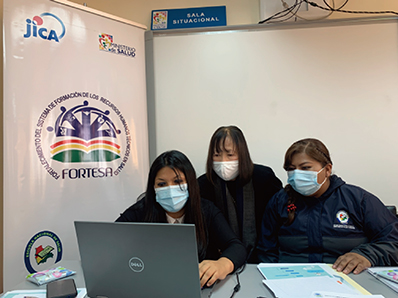
A JICA expert providing technical instruction on the planning of teaching guidelines based on the new curriculum for the training of medical technicians to her main counterparts, the principal of the National School of Health in La Paz and the principal of the Bolivian-Japanese Technical School of Health in Bolivia (Photo: JICA)
Japan has attached importance to initiatives to improve healthcare that are directly linked to human security for a long time. Japan has been actively leading the promotion of UHC and strengthening of health systems under the “Japan brand” at international forums including the G7, G20, TICAD, the UN General Assembly, and more (see Part I for Japan’s Support in Response to COVID-19 including the COVAX AMC Summit, see “ODA Topics 3” for details on the Tokyo Nutrition for Growth Summit 2021).
On September 24, 2021, then Prime Minister Suga gave an address in the form of a video message to the General Debate of the 76th session of the UN General Assembly. In his address, he mentioned contributions to the discussions on WHO review and reform, the importance of UHC, the formulation of the “Global Health Strategy” and Japan’s contribution to building a new architecture for global health security, and support for discussions on “human security” of the new generation, held under the UN toward building resilient global health systems. He also stated that Japan would hold the Tokyo Nutrition for Growth Summit 2021 in December 2021.
In addition, on September 30, 2021, then Foreign Minister Motegi co-hosted the High-Level Side Event on UHC on the margins of the UN General Assembly Note 42 in virtual form. In his video message, he reiterated Japan’s determination to exercise leadership toward achieving UHC based on the lessons learned from COVID-19.
At the G20 Joint Finance and Health Ministers’ Meeting held in Rome in October 2021, G20 members reaffirmed their commitment to the G20 Shared Understanding on the Importance of UHC Financing in Developing Countries, which was compiled in 2019 under Japan’s G20 Presidency. At the G20 Rome Summit in the same month, Prime Minister Kishida introduced Japan’s hosting of the Tokyo Nutrition for Growth Summit 2021 in December and stated that Japan would contribute to addressing global malnutrition from a comprehensive perspective, including health and food. The G20 Rome Leaders’ Declaration confirmed the commitment to achieve the health-related SDGs, in particular UHC.
■ Promotion of UHC (Japan’s Concrete Contributions)
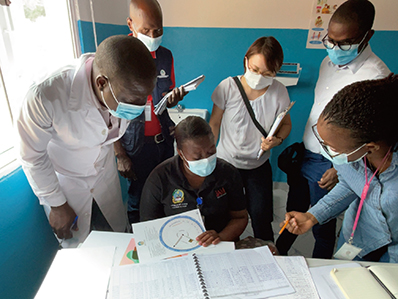
A Japanese expert visiting health centers that began distribution of Maternal and Child Health (MCH) Handbooks and providing assistance such as in-facility training in Angola (Photo: JICA)
Under the “Basic Design for Peace and Health (2015),” the Government of Japan provides assistance to achieve UHC that aims to “leave no one behind” (see also “Master Techniques from Japan to the World 1,” and “Project Introduction Columns” on Zambia and the Solomon Islands). In addition, in light of COVID-19 and various other changes in the global situation, the “Global Health Strategy,” which aims to realize renewed UHC for the post-COVID-19 era and strengthen response capacity, prevention, and preparedness for public health crises, is planned to be formulated as early as possible by June 2022.
Primary healthcare services under UHC comprise all services ranging from nutritional improvement, vaccination, maternal and child health, sexual and reproductive health, infectious disease control, non-communicable disease (NCD) control, and comprehensive community care and long-term care for the elderly (see “(8) Food Security and Nutrition” regarding nutritional improvement).
Especially with regard to maternal and child health in developing countries, there are still significant challenges, and in 2021, Japan supported many countries including Kenya, Madagascar, Bangladesh, Pakistan, Cambodia, and Laos to improve maternal and child health.
Furthermore, Japan implements activities utilizing the Maternal and Child Health (MCH) Handbook as a means of improving maternal and child health, based on its experience and expertise. The MCH Handbook can contribute to the Continuum of Care (CoC) from pregnancy, childbirth, the post-partum period, Note 43 the neonatal period, infancy, and to early childhood. It also enables mothers to acquire knowledge about health, which in turn raises awareness and encourages behavior modification. To give an example of the concrete assistance, the MCH Handbook is widely used throughout the country in Indonesia as a result of Japan’s cooperation. Moreover, among the countries promoting the use of the MCH Handbook, including Indonesia, Kenya, Tajikistan, Cambodia, Madagascar, Timor-Leste, Laos, and Papua New Guinea, there have been sessions to share their experiences and learn from each other.
Japanese NGOs have also worked in the area of health and medical care using the Grant Assistance for Japanese NGO Projects scheme. In 2021, for example, AMDA Multisectoral & Integrated Development Services (AMDA-MINDS), a Japanese NGO, has built healthcare facilities, provided medical equipment and supplies, provided training for medical personnel to develop capacity, and conducted activities to raise awareness of health-related knowledge among the local residents in Dang District, Nepal in order to reduce maternal and child health disparities.
Japan works with development partners, such as the United Nations Population Fund (UNFPA), the International Planned Parenthood Federation (IPPF), and the World Bank, to promote maternal and child health that includes sexual and reproductive health services, and thereby improving the health of a greater number of women and children. Japan also contributes to increasing vaccination rates in developing countries through Gavi, the Vaccine Alliance, Note 44 and bilateral assistance (see also Part I for the activities of Japanese UNFPA personnel and COVID-19 vaccine support through the COVAX Facility).
In addition, the Asian Development Bank (ADB) raises the following three pillars of cooperation between the ADB and Japan to achieve UHC in the Asia-Pacific region, positioning “health” as one of the key priority sectors in its Strategy 2030: (i) building an institutional framework, (ii) accelerating human resources development, and (iii) investing in infrastructure. In April 2021, Japan began contributing to the ADB’s Japan Trust Fund for the purpose of providing technical assistance and small grants to support efforts based on these three pillars.
■ Strengthening Response Capacity, Prevention Measures, and Preparation for Public Health Emergencies
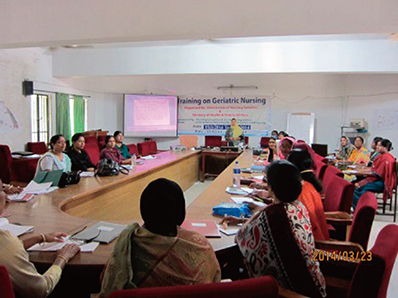
A discussion on the quality improvement of nursing education at a nursing college in Bangladesh
Japan has provided support for the health and medical systems in countries in Southeast Asia and Africa based on the view that building a sustainable and resilient health system is crucial to controlling infectious diseases. This support includes strengthening the capacity of prevention, preparedness, and response to public health crises through the development and creation of networks of core medical facilities and support for human resources development of medical workers. Japan also provides assistance in a wider range of areas, including development of water and sanitation infrastructure such as water supply and sewage systems and food security enhancement, to create a society that is more resilient to infectious diseases (see Part I for bilateral assistance on COVID-19 countermeasures).
Japan also provides assistance through the UN and international organizations, including contributions to the WHO Health Emergencies Programme* and the Contingency Fund for Emergencies (CFE)* during the response to the spread of the Ebola virus disease that has continued in the Democratic Republic of the Congo since 2018, and the response to the COVID-19 pandemic in 2020 and 2021. Furthermore, in 2021, Japan provides assistance for strengthening capacities in preparedness and responses against infectious diseases in developing countries, including through the additional contribution of ¥5.4 billion to funds such as the Health Emergency Preparedness and Response Multi-Donor Trust Fund (HEPRTF) launched in cooperation between Japan and the World Bank Group in 2020.
■ Responding to Antimicrobial Resistance (AMR)
Antimicrobial resistance (AMR) Note 45 is a serious threat to public health, and in recent years, more and more countermeasures against AMR have been taken. In order to advance measures against AMR, Japan promotes the “One Health Approach” for those who are engaged in the field of health concerning humans, animals, and the environment to work together on efforts. Based on the agreement at the G20 Osaka Summit to promote the “One Health Approach,” in 2019, Japan announced that it would contribute approximately ¥1 billion to the Global Antibiotic Research & Development Partnership (GARDP), which promotes research and development for new antibiotics and diagnosis development. Japan exerts leadership for AMR measures including through participation in the AMR leadership group. In 2021, Japan contributed approximately ¥200 million to GARDP.
Zambia
(1) Project for Upgrading of Lusaka Health Centres to District Hospitals (Phase 1, Phase 2), (2) Project for Strengthening Management Capacity of the First Level Hospitals in Lusaka District
(1) Grant Aid (Phase 1: 2013 – 2016, Phase 2: 2017 – 2021), (2) Technical Cooperation Project (May 2021 – May 2026)
In Lusaka, the capital of Zambia, there is a lack of Level 1 hospitals*1 capable of performing basic surgical operations and exams despite the rapidly growing need for medical care due to rapid population growth and urbanization. This means that the university hospital and other high-level medical institutions are obliged to carry out basic surgical operations, causing them to become chronically congested and unable to deliver adequate medical care. Moreover, the quality of operational management and services at Level 1 hospitals has also become a challenge.
Therefore, from 2013 to 2021, Japan carried out infrastructure developments through grant aid by constructing hospital wards and providing medical equipment to upgrade five health centers*2 located in the center of high-density residential areas in Lusaka, aimed at upgrading these centers into Level 1 hospitals with inpatient facilities that are capable of performing basic surgical operations and cesarean sections.
As a result, two Level 1 hospitals were opened in 2016, enabling residents to receive medical care services at their local hospitals. The number of cesarean sections performed and the number of inpatients admitted to the adult wards of the hospitals have increased from 0 (in 2012) to 1,396 operations and 1,757 patients (in 2019) respectively. Furthermore, these hospitals are now able to manage basic surgical operations and exams, the percentage of patients referred to the university hospital has decreased from 24.7% (in 2012) to 15.9% (in 2019), which has helped to alleviate congestion at the university hospital. Similar effects are expected at the other three hospitals, where construction of the buildings was completed in 2021.
In May 2021, Japan also launched a technical cooperation project that is providing technical assistance such as the improvement of service quality and capacity building in hospital operational management. The project is also providing support for human resources development to ensure that the Level 1 hospitals in the district provide high quality medical care and will be chosen by local residents.
Japan has increased the number of hospitals providing quality medical care through its 13 years of assistance in both infrastructure development and human resources development. Going forward, Japan will continue to cooperate with the people in Zambia to achieve Universal Health Coverage (UHC) across Africa as expressed at the Tokyo International Conference on African Development (TICAD).
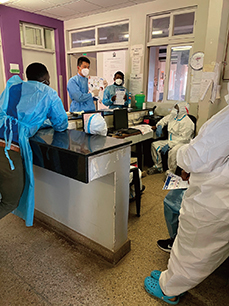
Mr. NORIZUKI, a Japanese expert, working with local infection control officials to give a demonstration of putting on and removing personal protective equipment (PPE) at the obstetrics ward of Chilenje Hospital, which has become a hospital dedicated for COVID-19 treatment (Photo: JICA)
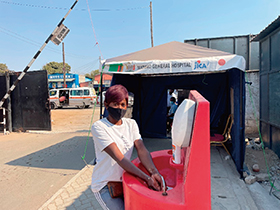
Instruction has also been provided to hospitals on enforcing temperature checks and handwashing for all visitors before entering hospitals, with the aim of making hospitals resilient against COVID-19 (Photo: JICA)
*1 Healthcare services in Zambia are categorized by facility level into six grades namely, health posts, health centers and hospitals from Level 1~Level 4.
*2 The Project for Upgrading of Lusaka Health Centres to District Hospitals developed facilities and medical equipment at two health centers (Matero and Chilenje) in Phase 1, and at three health centers (Chipata, Kanyama and Chawama) in Phase 2.
■ The Three Major Infectious Diseases (HIV/AIDS, Tuberculosis, and Malaria)
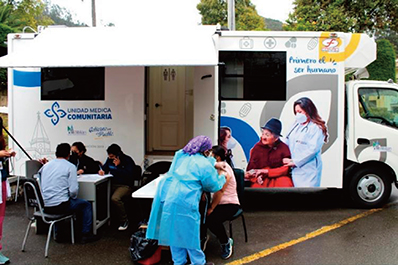
An equipped mobile medical vehicle, which was provided through Grant Assistance for Grass-Roots Human Security Projects, visiting parks in Biblián City, Cañar Province, Ecuador to administer vaccines to the citizens
SDGs target 3.3 sets out to end epidemics of the three major infectious diseases by 2030. Japan makes strong efforts to support measures against the three major infectious diseases and strengthen health systems through the “Global Fund to Fight AIDS, Tuberculosis and Malaria (the Global Fund).” Note 46 Since its establishment at the end of December 2021, Japan has contributed approximately $3.46 billion to the Global Fund. Furthermore, Japan makes it possible to supplement the efforts of the Global Fund through bilateral aid in order to ensure that measures against these three major infectious diseases are implemented effectively. Japan also strives to strengthen mutual cooperation on enhancing health systems, community empowerment, and policies for maternal and child health in those countries.
Japan provides assistance such as spreading knowledge to prevent new infections and promoting testing and counseling as bilateral assistance for HIV/AIDS countermeasures. In 2021, JOCVs continued to engage vigorously in the activities related to the disease, especially in Africa. These activities include spreading knowledge on prevention of HIV/AIDS and promoting understanding of the disease among as many people as possible and providing care and support for people infected by HIV/AIDS.
With regard to tuberculosis, based on the “Stop TB Japan Action Plan,” which was revised in 2021, Japan engages in reducing the annual number of deaths from tuberculosis in developing countries, particularly in Asia and Africa. These efforts aim to achieve a 75% reduction of the number of deaths from tuberculosis (compared to 2015) and a 50% reduction in tuberculosis incidence (compared to 2015, fewer than 55 cases per 100,000 people) by making use of Japan’s own experience and technology to take measures against tuberculosis through a public-private partnership (see “Project Introduction Column”).
In addition to these efforts, with regard to malaria, one of the major causes of infant mortality, Japan provides assistance for anti-malaria countermeasures such as initiatives through the strengthening of local communities in Myanmar and Solomon Islands. Through contributions to the Global Fund, Japan also takes measures against malaria worldwide, including in the Greater Mekong Subregion. Note 47
30 African Countries*1Public nomination
Pediatric Drug-Resistant Tuberculosis (DR-TB) Initiative
Stop TB Partnership’s Global Drug Facility (April 2019 – September 2020)
Across the world, each year, approximately 25,000 children under the age of 15 develop drug-resistant tuberculosis (DR-TB), which is difficult to treat with existing antibiotics. According to the World Health Organization (WHO), a total of 12,219 children*2 have undergone treatment for DR-TB since 2018. However, this is merely 11% of the five-year target of “treating 115,000 children by 2022” set out by the 2018 UN High-Level Meeting (UNHLM) on the fight against tuberculosis (TB). This means that most of these children’s lives are still at risk.
In support of the Government of Japan, the Stop TB Partnership’s Global Drug Facility (STBP/GDF) launched in April 2019, a project aiming to introduce and ensure the general adoption of new child-friendly drugs (including the new Japanese drug delamanid). STBP/GDF has successfully brought down the price of pediatric drugs by increasing the number of suppliers to ensure more children in need are secured access to these drugs. As a result of this project, more than 800 children in 30 African countries have gained access to DR-TB drugs in just over a year (by September 2020). Advocacy activities have also been rolled out to increase global awareness about the necessity to treat DR-TB in children, including mass media campaigns in which Hello Kitty has starred as the “TB Champion.”
Detecting and diagnosing more children affected by DR-TB and providing appropriate treatment remain essential in the fight against DR-TB. At the same time, the global COVID-19 pandemic has shown that increased multi-sectoral collaboration is critical in saving lives. Therefore, the Stop TB Partnership is committed to continuing its efforts and supporting the treatment of more and more children with DR-TB through cooperation and partnerships with various governments, multilateral organizations, and others.
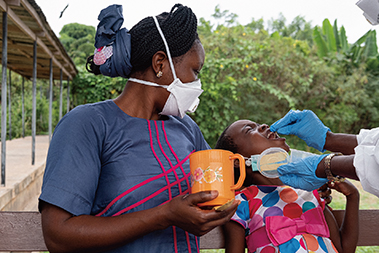
A child taking treatment drugs at University College Hospital (UCH), University of Ibadan, Nigeria (Photo: Stop TB Partnership)
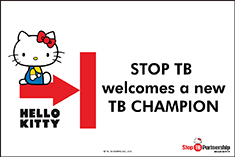
Educational video featuring Hello Kitty as the TB Champion (https://www.stoptb.org/advocate-to-endtb/hello-kitty) (Photo: Stop TB Partnership)
*1 The 30 countries are Angola, Botswana, Burkina Faso, Cameroon, Côte d’Ivoire, Chad, Democratic Republic of the Congo, Eswatini, Ethiopia, Ghana, Guinea, Kenya, Lesotho, Liberia, Malawi, Mali, Morocco, Mozambique, Namibia, Niger, Nigeria, Rwanda, Senegal, Sierra Leone, Somalia, South Africa, Tanzania, Uganda, Zambia, and Zimbabwe
*2 Estimate from the Global Tuberculosis Report 2021.
■ Polio
Although polio is on the brink of being eradicated, Japan has worked mainly in cooperation with UNICEF to provide support for its complete eradication with a focus on countries where cases of infection are still being identified (polio-endemic countries: Afghanistan and Pakistan). In August 2020, Nigeria, the last polio-endemic country in Africa, was certificated to have had no cases of wild polio for the past three years, and Africa was declared to be wild polio-free. Japan continues to provide a wide range of assistance to Nigeria, including support for vaccine procurement, development of cold chains Note 48 including solar-powered refrigerators for transport and storage, and human resources development for polio researchers through JICA training programs.
■ Neglected Tropical Diseases (NTDs)
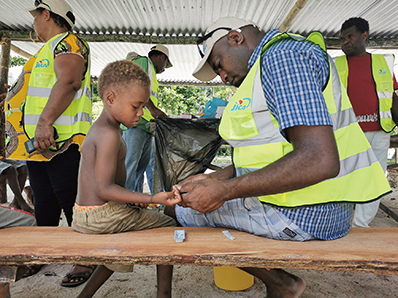
A New Ireland Provincial Health Authority staff member in Papua New Guinea checking a child for filarial infection (Photo: JICA)
Parasitic and bacterial infections, such as Chagas disease, Filariasis, and Schistosomiasis, are known as “neglected tropical diseases (NTDs),” and have infected more than 1 billion people worldwide, causing major socio-economic losses to developing countries. Since infectious diseases can have an impact beyond national borders, the international community must work as one to combat them. Thus, Japan also cooperates closely with all the relevant countries and international organizations on countermeasures against NTDs.
Since 2000, Japan has provided support against Filariasis for Pacific Island countries through technical cooperation. The Project for Elimination of Lymphatic Filariasis in the Pacific Region supports mass drug administration in the target countries with public-private partnership through the dispatch of Japanese experts to provide technical instruction, and utilization of drugs provided free of charge by the Japanese pharmaceutical company Eisai. This long-term support has proved successful, with eight of 14 Oceanian countries (Cook, Marshall, Nauru, Niue, Palau, Solomon Islands, Tonga, and Vanuatu) having eliminated Filariasis. Continuing from this, in October 2019, the WHO declared Kiribati to have eliminated lymphatic Filariasis. Through the dispatch of experts and other means, Japan will continue to support plans for the elimination of Filariasis in Pacific Island countries.
Glossary
- WHO Health Emergencies Programme
- The WHO Health Emergency Programme is a part of the WHO that responds to health emergencies. It evaluates the health emergency response capacity of countries, supports drafting of plans, and monitors new and ongoing health emergency situations. It also provides health services to save lives in countries where health emergencies are occurring.
- Contingency Fund for Emergencies (CFE)
- An emergency fund for responding to outbreaks and states of emergency established by the WHO in 2015 based on its reflection concerning the Ebola virus outbreak in West Africa in 2014. Decision-making regarding contributions is entrusted to the WHO Director-General, and it is possible to provide funding within 24 hours of the decision being made.
- Note 39: According to the United Nations Children’s Fund (UNICEF), the World Health Organization (WHO), and others (as of 2019). The previous total was over 5.3 million children.
- Note 40: According to UNICEF, WHO, and others (as of 2018). The previous total was over 295,000 women.
- Note 41: UHC aims at ensuring that all people can receive the quality health services they need at an affordable cost without financial hardship.
- Note 42: A side event aimed at discussing cooperation and collaboration in order to achieve UHC around the world with the prospect of the UN General Assembly High-Level Meeting on UHC in 2023, in which year Japan will take on the G7 presidency.
- Note 43: The period after childbirth in which the woman recovers to a similar condition before pregnancy, usually around one to two months after birth.
- Note 44: See the glossary.
- Note 45: Pathogenic microorganisms, including bacteria and viruses, gaining resistance to antimicrobials such as antibiotics and antiviral drugs, which causes the drugs to lose sufficient efficacy.
- Note 46: Established in 2002 based on the agreement at the G8 Kyushu-Okinawa Summit held in 2000.
- Note 47: Cambodia, Laos, Myanmar, Thailand, Viet Nam, and parts of China in the Mekong River Basin.
- Note 48: See Note 2.
